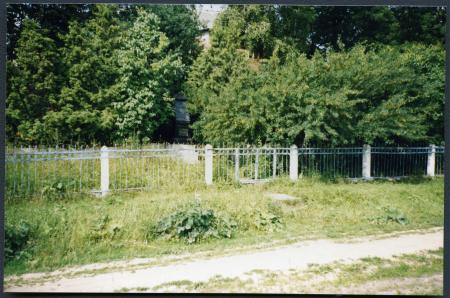Obj. ID: 6103
Jewish Funerary Art Holocaust Monument at the Killing Site in Dzyarzhynsk (Dzerzhinsk), Belarus, 1940s

Memorial name:
No official name.
Who is Commemorated?
1600 Jewish Holocaust victims from Dzyarzhynsk (Dzerzhinsk), killed on October 21, 1941.
Description:
The monument, commemorating the Jewish Holocaust victims from Dzyarzhynsk (Dzerzhinsk), is erected at their killing site/mass grave on Pervomayskaya Street.
It is shaped like a black granite obelisk standing on a three-step base. The monument bears two non-identical inscriptions: in Yiddish and Russian. The inscriptions are enclosed by a wreath. An additional Russian inscription is carved at the top of the monument. On its back, the sculptor's name is engraved.
The monument is surrounded by a fence.
Inscription
At the monument's top:
In Russian
В жизни
и смерти неразлучимы
Translation: Inseparable in life and death.
At the monument's central part:
In Yiddish:
[...]
In Russian
Здесь лежат 1600
граждан города
Дзержинска
погибшие от руки
фашистских убийц
Translation: Here lie 1,600 / civilians of the town / of Dzerzhinsk, / who perished at the hands / of the fascist murderers.
On the monument's base:
In Russian
21 октября
1941 г.
Translation: October 21, 1941.
On the monument's back:
In Russian
Спришен
Минск
Translation: Sprishen / Minsk.
Commissioned by
The victims' relatives.
sub-set tree:
On the back of the monument, in Russian:
Спришен
Минск
Translation: Sprishen / Minsk.
Dzyarzhynsk (Dzerzhinsk) was occupied by the Germans on June 28, 1941 [Yad Vashem: The Untold Stories]. In August 1941, all the Jews of the town were moved into a ghetto. The liquidation of it took place on October 21, 1941. On that day, the Germans forced the workers of the local kolkhoz, as well as Soviet prisoners of war (about 80-120 people), to dig a pit. The pit – 25 meters long, three meters wide, and three meters deep – was on Pervomayskaya Street, opposite the Protestant Church near the former Polish school. The Germans surrounded the whole area. When the preparations were complete, the Jews were taken to the pit in groups of 15-20 on the pretext that they were being relocated. They were forced to lie down in the pit and were then shot to death. The killing lasted until evening. After the shooting, the men who had dug the pit covered it with earth [Yad Vashem: The Untold Stories].
The commemoration began no later than 1949 when the present monument was erected by Mordukh Sprishen. Sprishen was arrested for his role in the commemoration of Jewish victims: he was accused of creating “Jewish art.” He was released only after the death of Stalin. [Yad Vashem: The Untold Stories]
Today the monument is the place of the commemorative ceremonies.
In 1975, an additional monument was erected near Dzyarzhynsk (Dzerzhinsk) at the Dzyarzhynsk-Stańkava (Dzerzhinsk-Stankovo) railway killing site [Yad Vashem: The Untold Stories].
"Dzerzhinsk,"
Untold Stories - Murder Sites of Jews in Occupied Territories of the USSR (Yad Vashem project), https://collections.yadvashem.org/en/untold-stories/community/14621652-Dzerzhinsk, https://collections.yadvashem.org/en/untold-stories/community/14621652.
"Execution of Jews in Dzerzhinsk,"
The Map of Holocaust by Bullets, Yahad-In Unum, http://www.yahadinunum.orgwww.yahadmap.org/en/#village/dzerzhinsk-minsk-belarus.389.
"Ghetto v Dzerzhinske (Minskaia oblast')
Wikipedia, https://ru.wikipedia.org/wiki/Гетто_в_Дзержинске_(Минская_область).



